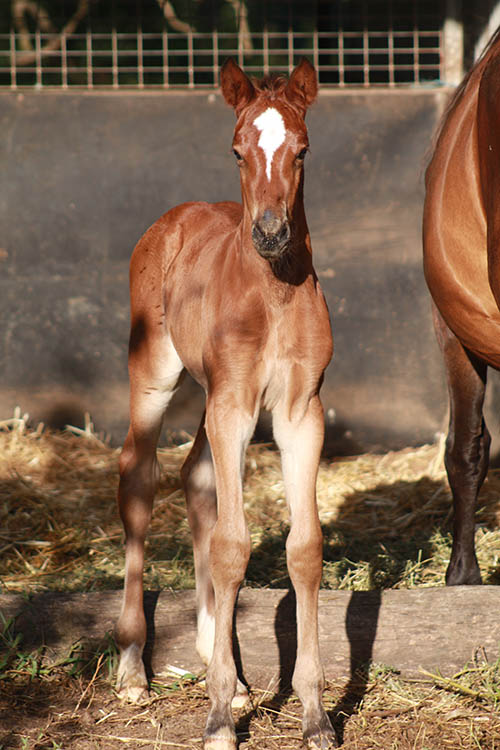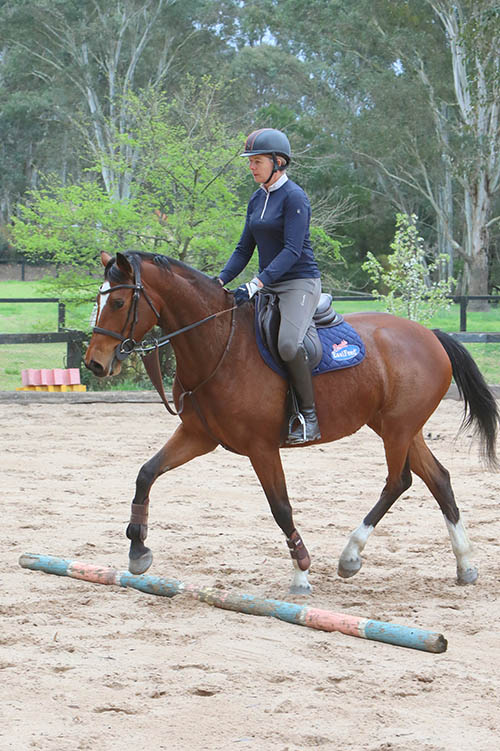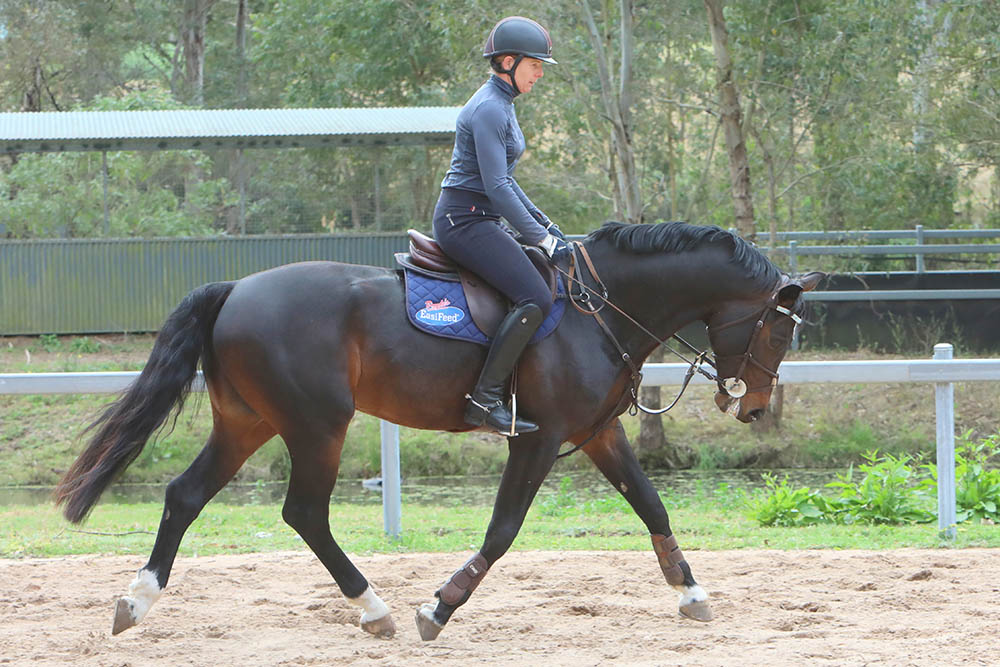There is no better place to start when producing international showjumpers from Australia than at Diamond B Farm. It has a proven combination of expertise, breeding and genetics through to foaling-down, weaning, breaking-in and young horse training.

Under Helen Chugg’s guidance, Diamond B has established a well-worn road to Grand Prix and international careers, a path trodden by the likes of Vivant, Conquistador, Sky High, Scandal, Colthaga, Kayak van het Gravenhof, Baluga, Alondra, Vigo, and now Diamond B Vivienne, to name a few. The successes are due to a combination of Helen’s experience, Amanda Madigan’s skills, and now Craig Weeding’s magic touch at breaking in the babies.
Chris and Helen Chugg enjoyed a very successful career in show jumping after they established Diamond B at Freemans Reach in the Hawkesbury area in 1985. Chris’s exploits on the world stage are legendary, many on their own bred horses. Helen’s breeding successes have proved equally legendary, beginning with off-the-track thoroughbreds and moving into warmbloods. With all her trips to World Cups, Olympics and World Equestrian Games, Helen quietly became an international expert in breeding top sport horses, especially showjumpers.
Enter another member of the Diamond B team in Amanda Madigan. Amanda’s rounded horsewoman skills and inner strength to succeed make her the ideal rider to complement Helen’s breeding and rearing expertise. From breaking to dressage, eventing and show jumping — and having had help along the way from people such as Fiona John, Nadine Merewether, Ann Battley, and her idol George Morris — Amanda’s empathy for horses and their ability to perform has proved indispensable.
“What Amanda has that sets her apart from so many is passion,” says Helen. “She is always prepared to do the hard yards. Her work ethic is one in a million and she remains always focused on the end goal — to win at Grand Prix. She leaves no stone unturned.”
You can read more about the history of Diamond B Farm, as well as Helen and Amanda’s equestrian backgrounds, in the November 2020 issue of Equestrian Life.
I ask Helen and Amanda what is it about the philosophy and techniques at Diamond B farm that sees them produce so many good horses. Is it the training that really makes the horse?
HELEN: “We know the bloodlines really well. We know what stallions produce what traits and we know all the mares that we breed to. It is certainly not whimsical and I research so much and watch videos and listen to international breeders. I always look at the breeding and ability and traits of mare and stallion bloodlines so that when I match a mare to a stallion it is with a lot of thought and research before doing this.
“I also realise that not every foal is going to be a world beater in jumping. I have to have in mind to be able to outsource the progeny to other disciplines if they are not super-talented showjumpers. So then, movement, type and temperament are of a high priority.”



AMANDA: “I love to handle the foals and get a feel for them from when they hit the ground. They are all very different, but having ridden, say, Vivant, Conquistador and many of the now broodmares, I see a lot of traits from the parents in the progeny. So I have an insight and idea of the approach to handling and riding of each one as I have an anticipation of what to expect. I no longer break them in so it’s very important to have a great rapport with the person who is breaking them in, and we have just that with Craig Weeding who does all of ours now. He is now training and racing horses in Wangaratta, Victoria, but that doesn’t change the fact that we send them to him as he is an excellent horseman and totally respects and knows what we want done with the babies.
“Every person along the training scale with horses has their specific part to play and we like everyone to do just that. We like to keep it very raw and simple, especially in the beginning, and Craig doesn’t try to make the 2½-year-olds go like elementary dressage horses after six or so weeks. He knows what we want. We want confident horses that are taken slowly when need be. We like them to stand in the cross ties and stand to be mounted. They simply need to accept an even, steady contact and to go forward from the leg, and that they bend and follow the rein left and right and to stop.
“Craig rides them in open paddocks and takes them on bush and road rides. They all learn about hobbles, they learn patience and are always confident and easy to deal with when they come home. He is respectful and passionate and he loves to chat about the traits they have. He already has a great understanding of the bloodlines and also an insight into how they need to be treated according to their parentage, as he has now broken in mothers of progeny he deals with! ‘Oh, that’s out of X… I know that will be generous’ etc.
“This is the first step, and despite all steps being vitally important, Craig’s honesty with the horses is of the utmost importance as this is a time when they are not in our sights. We so trust Craig who lets us know every detail — what was good and often enough a trait that wasn’t so good that needed patient sorting out. If there is one that needs more time, he can keep them until he has it sorted. There is no time frame as this can be the undoing of a good horse that often needs time in the beginning. To be a good horse in jumping they need a bit of fight… it just needs understanding and direction and that’s what a good breaker will do.
“When the horses return, Craig will say if any need further riding, but that is rare and as they have travelled, had to cope with a new venue, been broken in, lost a bit of weight — that is always normal with the process — then Helen likes to see them have a break in the paddock and they are allowed back to their well-known herd life. Up until now, as foals and as weanlings and yearlings, they all grow up in a herd environment as Helen believes they need to learn about pecking orders and to be responsible for themselves. Helen especially likes the colts to be in with an older alpha mare or a quiet bossy gelding.”





HELEN: “It’s so good to have them home and they really let down well and feel at ease after their time away. I like to see them have six months off so they are then 3½ and strong enough to cope with more work. They really forget nothing they have learned and are keen to learn again. The break does them the world of good, and when we bring them back in to continue with them they have a few days on the walker, which they are familiar with as we put them on as weanlings and yearlings, and then Amanda takes the reins.”
AMANDA: “I always lunge them with saddle and bridle on and, with Craig’s advice, a bit that suits. Saying that, it’s 90% of the time a dead plain snaffle and a Cavesson or Hanoverian, never tight but also not loose. Craig always uses nosebands, as it’s another thing we like them to be used to. I will often use a running martingale and that’s also something Craig introduces so there are no surprises.
“As for energy levels, we never feed them up too much as baby horses as they need to keep good legs, and too much feed not only can create leg and joint problems, but also excess energy doesn’t help with concentrating on their job. We are very fortunate to be sponsored by KER and Pryde’s. We ask them a lot and take advice from those experts in their fields, and that is so important when it comes to raising healthy, strong young horses all the way through to the top competition horses.
“After lungeing, I will get on with Helen always there and ride in the round yard to get a feel — and what is so good is it’s always as I hoped and as Craig had said. They are always so good! He does a super job, honest and simple; they are a blank canvas in terms of frame yet I can always get an even feel and that’s all I want at this stage.
“Washing down is easy and they all learn to have their heads hosed and then to relax in the cross ties in the sun to dry! After a day or two riding they then make their way to the dressage arena that’s set next to the jumping arena, and I simply like to ride open lines (the arena is 60x30m) and keep them forward of their own volition. Never running or pinging off and never backwards. As far as contact goes, they need to balance and bend left and right, and have a feel that they can listen and move away from an inside leg (something Craig also initiates) as without this, turning and flowing lines and changes of direction are not possible.

“I start canter after a warm-up in trot and don’t hide away from cantering quite a lot as it is canter and balance in this that is all important. My young ones at this stage need to give an even feel in the contact and sure need to be pliable, but I like to ride then in a frame that they are normal and comfortable about and make sure I firstly have a good pushing hind leg. One of my pet hates is for them to push down and out and I try to nip this in the bud as I know when it comes to jumping on landing, and as you get to take-off, the pushing down is not a good thing at all!”




HELEN: “We sometimes free-jump the babies before they go to Craig’s, but really free-jumping is something that makes us feel good if they jump spectacularly — and sometimes disappointed with those you expect to jump and look average. It’s often got not a lot to do with the final outcome but it does tell you about attitude and incentive to be brave etc. Needless to say, they change so much and some super free-jumpers are not as good under saddle and others surpass expectations.
“I love to see my horses brought along patiently but with definite boundaries. I often help Amanda with what I see from the ground. Again, in that first three months training as 3½-year-olds, we just want it open and uncomplicated; balanced paces and confident and uncomplicated. Of course, we always feel towards the softer yielding contact and reward the feeling, but we are NOT trying to compress the frame without a confident and forward horse, and I am sure the approach for us for jumping is slightly different to that for dressage. We always start them with the thought of them being a showjumper; it will not be for some time before a decision may be made towards another discipline, in which case the training is complementary.”
AMANDA: “In the three months or so we expose them also to the jumping arena and they get used to trotting around the jumps. They get used to watching other horses jump and the noises and happenings on the arena. The principles stay the same and it’s nice to have jumps to ride around, and with the wonderfully treed arena it so good to get good steering organised. Of course, I don’t need to say how important the outside rein is for straightness and as a guiding and balancing rein for the smaller turns. Inside leg to outside rein applies with me very importantly.

“I know people say that’s weird,
but it’s true, I know I feel it!”

“We have poles on the ground on the jump arena, and when the horses are well and truly confident and reasonably balanced, I will introduce the poles, first at walk and then at trot and then in canter. Poles, and for them to focus on the rail, is a very important part of being a good showjumper. I focus on balance and tempo and straightness going to and departing the rail. I never make a deal of it. Keep it simple… if they baulk, I put my leg on to encourage and keep them as straight as possible, and then after the rail I make a straight transition — either forward if they stall and don’t want to go, or a downward transition if they want to run away.
“I use a lot of voice that is a continued aid from their lungeing, and will also be important when starting to jump, to act as a backup aid to the leg (“cluck”) or a (“whoa”) for a slowing aid. Depending on the character and the nature of each youngster, the amount of time they will stay for this period is usually in the vicinity of three months and then we will turn them out again. Again, each horse is a separate training identity and sometimes we may jump some over a cross rail. I use a placing pole to trot, just over two metres from a low 60cm cross rail. It is not steep, perhaps 90cm at the wing. Then a rail at three metres out on the landing side to canter away from.
“The exercise is set where there is a straight approach and departure and maybe the first time the cross is just the rails on the ground. On landing, it’s usual to canter then trot, walk and halt and reward so they learn to relax and think about what they are doing. With the ones who are super forward it’s important to regain balance and togetherness on landing and for them not to run at the fence. If they do, I like to simply walk and halt straight at the cross or rail and then repeat until they don’t want to get excited and run. It’s always fun to start the babies off and, as I have mentioned, I often have ridden both parents and often feel similar traits in the contact and the quirky ways some have. I know people say that’s weird, but it’s true, I know I feel it!” EQ



